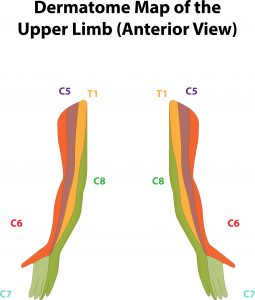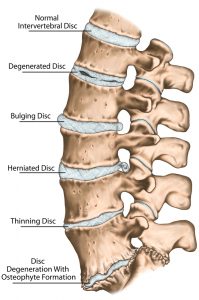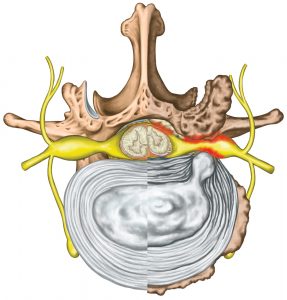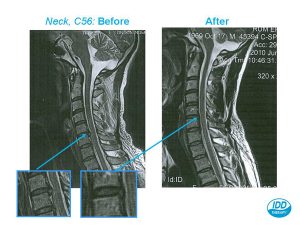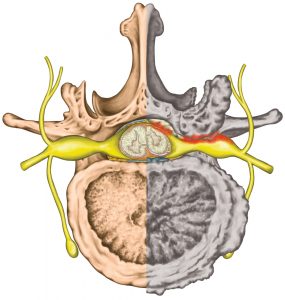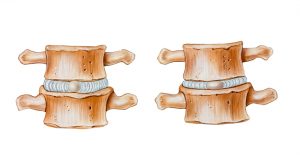Trapped Nerves in the Neck
The discs at the bottom of your neck at C4/C5 or C5/C6 or C6/C7 are the levels most likely to suffer from disc bulges or herniations as they help support most of the weight of your head.
The most common causes of trapped nerves are herniated and bulging discs, spinal stenosis, facet joint arthropathy and degenerative discs.
Our new IDD Therapy programme is effective in treating trapped nerves, is non-invasive (unlike surgery) and is pain-free. IDD Therapy bridges the gap between what manual therapy cannot achieve and surgery. This therapy is the fastest growing therapy for trapped nerves and degenerative disc issues in the UK.
Each vertebra in the spine has numbers as you can see in the diagram below. In the lower back or lumbar spine, the vertebrae are numbered L1 to L5. The chest or thoracic spine uses the letter T and is numbered T1 to T12, and the neck or cervical spine uses a C and is numbered C1-C7.
Slipped, herniated or disc bulges or protrusions usually occur at the bottom your neck.
The discs at the bottom of your neck at C4/C5 or C5/C6 or C6/C7 are the levels most likely to suffer from disc bulges or herniations as they help support most of the weight of your head. When these discs bulge or herniate, they can press on nerves which innervate your shoulder and arm.
There are also other conditions that can trap nerves in the neck apart from disc bulges and herniations which I will also outline (spinal stenosis, facet joint arthropathy and degenerative disc disease).
The image below shows the nerves in the nerves in the neck and just how complex they are. Any pressure on any of these will most likely cause shoulder and arm pain with pins and needles into the elbow, forearm or hand with varying intensity depending on the cause.
These nerves can become trapped for several different reasons and refer to the arm and shoulder. The areas a single nerve innervates in the arm and shoulder is called a dermatome and each specific nerve will be responsible for sensory perception in different areas (temperature, touch, vibration, pressure and pain). Therefore if a nerve is impinged in the neck, pain and pins and needles (or paraesthesia) will refer to any given dermatome.
Our new IDD Therapy programme is effective in treating trapped nerves, is non-invasive (unlike surgery) and is pain-free. IDD Therapy bridges the gap between what manual therapy cannot achieve and surgery. This therapy is the fastest growing therapy for trapped nerves and degenerative disc issues in the UK.
Herniated/Bulging discs in the neck
A disc bulge is where the outer wall of the disc bulges out from its normal position. The disc wall is not broken, and the nucleus material is contained inside the disc. As the disc bulges, it may press against nerves directly or the bulge is associated with a loss of disc height and this may lead to impingement of a nerve as it exits the spinal canal though the gap between two vertebrae.
A herniated disc is the same as a prolapsed disc. This is where the nucleus of the disc breaks through the outer disc wall. There will be a loss of disc height as the disc loses pressure and the nucleus material can press directly on to the spinal nerves causing pain. Or the material of the disc nucleus may act as a biochemical irritation to the nerve, in which case the result is the same… pain!
A ‘slipped disc’ is an everyday expression which doesn’t have a true medical definition. It can imply a disc bulge or a herniation, usually a herniation.
This MRI below demonstrates a disc bulge pressing on nerves in the neck. We also took an MRI scan of the same patient before and after IDD Therapy that we offer at Buxton Osteopathy Clinic. If you look carefully you can see the disc bulge has significantly diminished allowing this person’s symptoms to fully resolved.
The resulting pain from a herniated disc will often refer (hence the term radicular pain) down the pathway of a nerve and into the limb it innervates causing either sciatica (in the case of the lower back) or pain into the neck, shoulder and arm (if in the neck). This can often be accompanied with pins and needles in the foot or hand depending on this location.
Disc issues usually occur in the same areas of the spine time after time because no matter who we are we are made the same way.
Often these complaints don’t resolve overnight, and you will have experienced symptoms for some time. Often the options to treat these conditions may be limited. Pain killers and manual therapy often offer limited relief. Many people may wish to avoid surgery because of its related risks.
Our IDD Therapy programme can help treat trapped nerves, is non-invasive (unlike surgery) and is pain-free. IDD Therapy bridges the gap between what manual therapy cannot achieve and surgery. This therapy is the fastest growing therapy for trapped nerves and degenerative disc issues in the UK.
Spinal stenosis
Spinal stenosis refers to a build-up of bony deposits in the vertebrae. It is typically associated with the ageing process. As we get older, in the same way that our skin ages, so too do our discs. Everyone will have degenerative discs to some degree, it goes with the territory unfortunately.
In some cases, the loss of disc height as we lose water leads to more load pressure being exerted on the vertebrae.
The body reacts to the increased load by laying down more bone to reinforce the vertebrae. In some cases, the extra bone can narrow and exert pressure on the spinal cord (central stenosis) or exiting nerve roots (lateral stenosis).
Facet joint arthropathy
In the spine, facet joints link the vertebrae and are important for preventing excessive rotational and twisting forces which would damage the discs. They also share some of the load bearing of the spine.
When there is a loss of mobility in the spine, the facet joints bear a greater load than normal. This is particularly the case if there is some imbalance in the body and one side of the spine takes more strain than the other.
Imbalance in weight distribution not only adds to the stress borne by the facets but effectively deteriorates bone and cartilage. Constant movement on these worn structures activates an inflammatory reaction to the joint which is full of nerve endings. The result is chronic pain as the body continuously sends pain signals to the brain.
Just like the vertebra, the body reacts to the increased load on the facet joints by laying down more bone in the joint margins (this is called facet joint arthropathy). In some cases, the extra bone can narrow the gap where the nerves exit the spine and if the bone pinches against the bone, it can cause referred pain into the arm.
Degenerative disc disease
Disc degeneration is common in the neck (cervical spine) and lower back (lumbar spine). This is because these areas of the spine undergo the most movement and stress and are subsequently most susceptible to attrition.
Degenerative disc disease (or DDD) in some cases can generate symptoms in the neck, shoulder, arm and hand caused by wear-and-tear on a spinal disc. These symptoms can vary from weakness, numbness, shooting pains or dull aching in these areas. Generally, DDD produces low-level chronic pain with intermittent episodes of more severe pain.
In terms of composition discs are made of an inner toothpaste-like substance which is mainly comprised of water (nucleus pulposus) which acts as a compressible fluid ball-bearing and an outer fibrous wall (annulus fibrosus) made of collagen.
The spongy intervertebral discs absorb shocks and pressure from the load of our bodies and squash as we lean or bend in any direction. They stop the vertebrae rubbing against each other (bone on bone) and they create a space between the vertebrae. This space is very important.
Each vertebra has a hole in the middle and when the vertebrae are stacked on top of one another combine to form a tunnel or canal through which the spinal cord travels down from the brain.
In children, the discs are about 85% water. The discs begin to naturally lose hydration during the ageing process. Some estimates have the disc’s water content typically falling to 70% by the age of 70, but in some people the disc can lose hydration much more quickly (as seen in the bottom two discs below).
As the disc loses hydration, it offers less cushioning and becomes more prone to cracks and tears. The disc is not able to truly repair itself because it does not have a direct blood supply. As such, a tear in the disc either will not heal or will develop weaker scar tissue that has potential to break again. At the same time as the disc loses moisture and its structural integrity content it will protrude and bulge and can press on nearby nerves.


